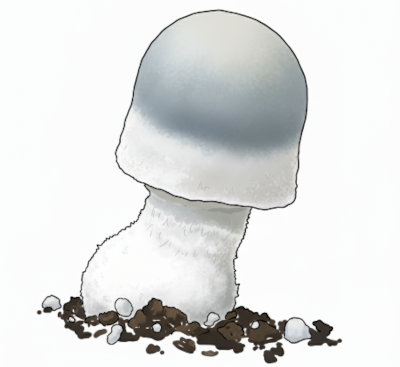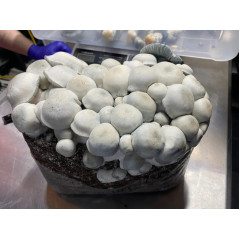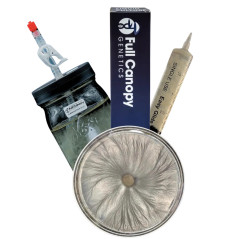History of the Albino Penis Envy (APE) strain
No one expected a strain of Psilocybe cubensis to become a legend. It wasn’t born in a university lab or a planned project, but on the workbench of a self-taught mycologist simply trying to improve an aesthetic trait. The result wasn’t beauty—it was potency. And unintentionally, he had just started a mycological legend: Albino Penis Envy.

Origin of the Penis Envy strain: McKenna, Pollock, and Gee
To understand the story of Albino Penis Envy (APE), we must first go back to the early 1970s, when ethnobotanist Terence McKenna was deep in the Colombian Amazon jungle. According to legend, documented by psychedelic journalist Hamilton Morris, McKenna discovered a massive patch of Psilocybe cubensis growing in Zebu cattle manure. The spores he collected from that expedition would give rise to one of the most controversial lineages in psychedelic mycology.
What happened next is a mix of mycological folklore and real tragedy. The spores ended up in the hands of Steven Pollock, a physician turned psychedelic mushroom enthusiast, who spent years isolating and perfecting a strain that displayed a strange mutation: the caps refused to open fully, and the stem swelled excessively, creating unmistakably phallic shapes. Pollock was murdered under extremely mysterious circumstances in 1981, officially related to drug trafficking, and according to the most novelistic accounts, he was found holding a Penis Envy mushroom.
After his death, a spore print simply labeled “Penis” arrived by mail to Richard Gutierrez, known in the community as Rich Gee, a Washington-based mycologist experienced in genetics and yeast cell cloning. Gee perfected the strain through selective breeding, propagating only the specimens showing the most intense bluing reaction — a direct indicator of psilocybin content.
Origin of the name: A baptism with strippers
As for the name, there’s a colorful 1977 anecdote. Gee planned to call it “Amazons,” but during a meeting with a group of strippers, they commented that the mushrooms looked like “donkey d***s.” Gee, with a sense of humor, replied, “Are you perhaps envious of the penis?” And thus, the name that would make underground mycological history was born.
The Penis Envy strain was already a legend in underground mycology thanks to its potency and unique shape. However, it wasn’t until two decades later that its lineage would cross with albinism, giving rise to a new level of power.
2006: The ‘birth’ of Albino Penis Envy
Two decades after Pollock’s murder, in 2006, deliberate hybridization of psychedelic mushrooms by underground mycologists under lab-quality conditions was in its early stages. John Workman, who leads research and development at Sporeworks, a rare spore supplier, had never bred a mushroom before and wanted to cross two strikingly different varieties to more easily confirm whether hybridization had succeeded.
“I needed strains that were obviously different to confirm the cross,” explained Workman, a self-taught mycologist from the Pacific Northwest. “It was just something to try, and I thought it would look cool. I did it for the challenge.” The rest has passed into mycological folklore, though Workman laments how the true story has become obscured over time.

The pieces of the genetic puzzle
It all began when Workman was working with the PF Albino strain, an ultraviolet mutation unintentionally created by Robert “Billy” McPherson, also known as Psilocybe Fanaticus (PF).
The PF Albino strain, a key element in the APE genetics, came from a pioneer. PF was a seminal figure in underground mycology, as he invented and popularized the “PF Tek” method — a home cultivation technique that democratized the growing of Psilocybe cubensis. By using PF Albino (a mutation that appeared by chance in his classic strain while growing under fluorescent lights), Workman was drawing from one of the foundational pillars of home mycology, highlighting the amateur yet innovative nature of the APE cross.
“PF assumed that the PF Albino was sporeless, but I found colorless spores on the gills. The albino spores were essential for what was to come.”
With both mushrooms in his possession since 2005, Workman set to work. He placed a monokaryotic culture of PF Albino into a jar of sterile grain and let it colonize. Using a monokaryotic culture was key: a single spore germinates into a monokaryotic mycelium, which must mate with another (in this case, PE) to form a dikaryotic mycelium that can ultimately produce mushrooms.
An unusual cross: Workman’s experimental method
“Each grain was covered in mycelium,” he wrote. He then made a fresh solution with dry Penis Envy spores and injected it into the already-colonized grain. He shook the jar to mix. It was an improvised method that mycologists typically avoid.
“Surprisingly, this method worked on the first try and produced some Psilocybe cubensis mushrooms that looked exceptionally normal, with no signs of mutations or abnormalities,” he recalled on his blog. “Since both varieties supposedly descend from early Amazonian collections, this may be a glimpse of how the original mushrooms looked when first collected.”
The hunt for recessive traits up to PE Uncut
This is where genetics got complicated. Workman selected spores from promising specimens and, after several rounds of grows, “finally” identified an early version of what he was looking for. The problem was that both the phallic structure (from Penis Envy) and albinism (from PF Albino) are recessive traits, complicating his search for a “pure white” Penis Envy mushroom.
To retrieve and fix those recessive traits, he intentionally selected mushrooms from his first generation of creations, then from his second. During his third grow, Workman managed to isolate a strain that was albino and displayed the distinctive penis shape. He called it PE Uncut (Penis Envy Uncut), considering it the most immediate precursor of what he was seeking.
He performed a few more grows to stabilize this creation, and thus, “We have the APE we have today,” he wrote. These mushrooms resemble phalli, with thick, robust stems that look ready to burst at the seams and are colored a pale ghostly white, crowned with bulbous caps that bruise deep blue.
Frustrated perfectionism
“It looks pretty good, but it still tends toward blue caps that sometimes abort,” he wrote on the Shroomery forum in December 2007, announcing the final step in a long process. “They’re nice but I was hoping for pure white mushrooms. The work will continue, but for now this is the best version.”
Despite his partial dissatisfaction, spore samples were made, sold online, and the rest is history. From Workman’s Petri dishes, APEs have gone global. They look like a Penis Envy mushroom but are white and generally smaller. At the time, Workman’s radical underground mycology peers knew he had done something special. “Bravo Workman, you’ve outdone yourself with this one,” one wrote. Within months, others were fruiting their own APEs. “Dude, Workman, you’re amazing. Thanks!” wrote another in August 2008, with a photo of his own APE grow.
Characteristics of Albino Penis Envy
How to recognize an APE at a glance
Albino Penis Envy mushrooms present distinctive morphological features that set them apart from other Psilocybe cubensis strains:
- Caps over 20 mm in diameter, bulbous and dome-shaped
- Stems growing up to 100 mm long, exceptionally thick and sturdy
- Ghostly white-gray coloration, almost bluish at the caps
- Deep blue bruising when damaged, indicative of high psilocybin concentration
- Completely transparent spores, invisible to the naked eye

Exceptional potency
Soon, the Albino Penis Envy strain became famous for its unusually high psilocybin content. “Anecdotal reports always rated APE as highly potent, but real results finally emerged in 2022 with lab testing at the Psilocybin Cup by Hyphae Labs, where APE ranked at or near the top in potency,” wrote Workman.
According to data from multiple competitions:
- Average psilocybin level: 0.93%
- Most potent sample by grower “Dr Greythumb”: 1.73% psilocybin and 0.61% psilocin
- In the most recent Hyphae Cup, an APE sample from grower “Hand of God” recorded over 3% total alkaloids — the most potent entry in the competition—
For context, psychonauts have reported intense trips after consuming less than 1 gram of APE mushrooms.
The irony of the creator
Workman emphasized he never intended to create a super-potent Psilocybe cubensis variety. “I created APE purely thinking of aesthetics,” he wrote. Crucially, he never tried the mushroom himself. “I’ve never eaten a mushroom I’ve grown, so I can’t comment on its effects directly,” he told DoubleBlind. “I’ve mostly just heard they’re terrifyingly strong and more intense than expected. But the same could be said about PE.”
The challenges of cultivating Albino Penis Envy
In underground dispensaries and online shops, APEs tend to be harder to find than Penis Envy mushrooms, mainly due to the increased difficulty of cultivating them. They require greater attention to humidity, temperature, and substrate conditions for optimal yields and remain, as Workman warned, “much more prone to aborting.”
APE cultivation characteristics
- Advanced strain to work with, not recommended for beginners.
- Low yield compared to other strains, limiting supply.
- Significantly longer maturation time than other mushrooms.
- Extremely low and transparent/ invisible spore production.
- Spore collection typically done with swabs due to transparency.
- Preferred substrate: bovine and equine manure and nutrient-rich soils in subtropical climates.
Given its low productivity, APE is considered a challenge. “The yield definitely sucks,” wrote a recent underground cultivator on the Shroomery forum. For this reason, the mushroom is often offered as a curiosity or novelty rather than a high-production strain. Sporeworks, for example, states in its online listing that APE lacks “the vigor and size of the original Penis Envy and is offered here solely for its novelty.”
Supplies are also limited due to poor spore production, making them more expensive than other varieties. The PNW Spore website adds that “A true Albino Penis Envy will drop very light spores, invisible to the naked eye. Spore collection is typically done using swabs.”
The albinism enigma: Were UVA rays a genetic factor?
In a Shroomery forum thread, Workman wondered if UV exposure might have caused the albinism in the original PF strain. “I later found in PF’s notes that the UV lights were just regular fluorescent black lights from Spencer’s Gifts (UVA) and probably not intense enough to cause genetic damage, but who knows,” he told DoubleBlind. “Maybe he placed the lights extremely close to the mycelium, and UVA can cause skin cancer, so it’s not impossible.”
Evidence-backed methods for turning mushrooms white might surface in the future, but however the APE strain came to be, it has already become one of the most sought-after.
Albino Penis Envy today
“I never expected any of this,” says Workman. “From the beginning, APE was found exceptionally potent based on anecdotal Shroomery posts, so it wasn’t a big surprise that when tested, it ranked at the top. But it’s been almost two decades since I began working on it, and it’s still popular, and I find that amazing. It was just pure luck, right place, right time, and a bit of curiosity to try something new.”
Now, most P. cubensis spore vendors sell APE or a variant of the strain. As one mushroom enthusiast wrote on Shroomery: “It’s true they grow kind of slow. It’s true it’s virtually impossible to get spores from them; just take a clone. The saying ‘a cube is a cube’ really doesn’t apply to APE or PE. They’re something completely different.”
The human factor
What makes this story particularly fascinating is how a self-taught mycologist, working from his home in the Pacific Northwest, with no intention of creating something revolutionary, ended up developing one of the most prized and potent Psilocybe cubensis varieties. Workman wasn’t seeking potency — he sought beauty. He had no formal academic training in mycology, just curiosity and a willingness to experiment with unorthodox methods.
And perhaps that’s the most important lesson from the story of Albino Penis Envy: significant breakthroughs don’t always come from well-funded labs or researchers with impeccable credentials. Sometimes they come from pure curiosity—from the urge to “see what happens,” from the willingness to break from established methods and try something new.
As Workman himself humbly admitted: “It was just pure luck.” What began as a clandestine aesthetic experiment became a global myth. If there’s a moral, it might be this: science progresses, but curiosity (and a bit of chaos) moves faster.
References and sources
- DoubleBlind Magazine. (2024). "The Origins of Albino Penis Envy, According to the Man Who Created It". https://doubleblindmag.com/albino-penis-envy-history/
- DoubleBlind Magazine. (2024). "Penis Envy Mushrooms: Murder & Conspiracy Behind the World's Trippiest Shroom". https://doubleblindmag.com/mushrooms/types/penis-envy/
- Tripsitter. (2024). "Penis Envy: The World's Trippiest Mushroom". https://tripsitter.com/magic-mushrooms/strains/penis-envy/
- Workman, John. Blog de Sporeworks. "APE Development History". https://sporeworks.com/news.php
- The Shroomery Forum. "Albino Penis Envy Discussion Thread". https://www.shroomery.org/forums/showflat.php/Number/7777258
- Oakland Hyphae Labs. "Psilocybin Cup Results". Oakland Hyphae Psilocybin Cup 2022
- Tripsitter. "APE Revert Strain Information". https://tripsitter.com/magic-mushrooms/strains/ape-revert/
- Eden Shrooms. "Albino Penis Envy Spore Syringe". https://www.edenshrooms.com/magic-mushroom-spores/
- PNW Spore. "What Are Penis Envy Mushrooms". https://pnwspore.com/what-are-penis-envy-mushrooms/
- Sporeworks. "Psilocybe cubensis Albino Penis Envy APE Product Listing". https://sporeworks.com/
- Hamilton Morris. Hamilton's Pharmacopeia (podcast y serie documental). Entrevistas con Rich Gee y documentación sobre Penis Envy.
- McKenna, Terence y Dennis. (1976). "Psilocybin: Magic Mushroom Grower's Guide" (bajo los pseudónimos O.T. Oss y O.N. Oeric).
- Gutierrez, Richard (Rich Gee) y Stevens, Jules. (1977). "How to Identify and Grow Psilocybin Mushrooms".






















